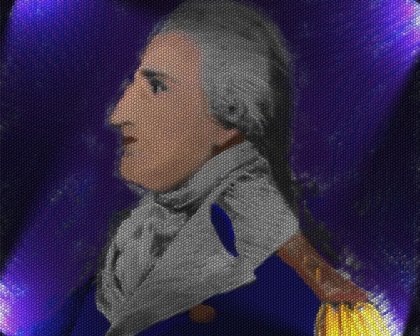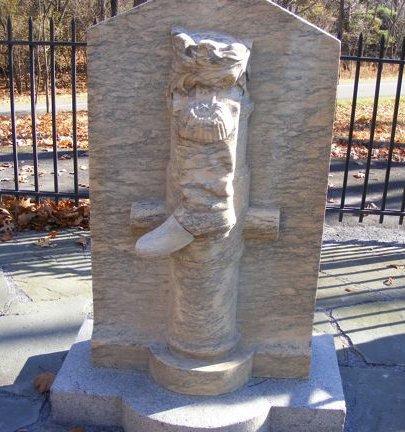
But that’s what you will find at the battlefield of Saratoga National Historical Park in New York, where American and British forces collided in September and October 1777. The missing name is that of America’s most famous traitor—Benedict Arnold. And his heroism occurred during one of the most important battles in American history.
In the fall of 1777, Gen. George Washington, who had been hoping to get France to join the American side, desperately needed a big victory to show the French that the upstart country was worthy of their support. At the same time, the British had devised a plan to crush the colonial uprising before France could enter the war.
The battles of Saratoga
British Maj. Gen. John Burgoyne, the author of the plan, was stationed near Montreal. He figured that if British forces could gain control of New York’s Hudson River, they could separate neighboring New England from the rest of the rebellion and more easily conquer a geographically divided Continental Army.
Burgoyne proposed marching south from Canada to the Hudson and following it to Albany. Another British force, led by Brig. Gen. Barry St. Leger, then camped at a fort on Lake Ontario, would move east along the Mohawk River and also end up at Albany. In a third prong of the plan, Maj. Gen. William Howe, in control of British-occupied New York, would take a force northward along the Hudson and join the others at Albany.
Burgoyne began his journey from Canada on June 17, 1777, and on July 6 took New York’s Fort Ticonderoga from the Americans, who had captured it on May 3, 1775. The American capture of the fort, near the Vermont border, had been the work of Vermonter Ethan Allen’s famous Green Mountain Boys and a lesser-known Connecticut militia company, led Capt. Benedict Arnold.
As Burgoyne’s troops continued their trek toward Albany, they battled American units several times along the way, which weakened the British force.
Meanwhile, St. Leger was trying to seize American-held Fort Stanwix, which stood in his path to the Mohawk. He started the siege on Aug. 3, and American troops around Albany were sent to reinforce the fort. When St. Leger learned about the approaching force, he called off the siege on Aug. 22 and returned to Canada. The arriving Americans were led by Benedict Arnold, who had risen to major general in the Continental Army.
The third prong of the plan also fizzled. Howe decided to lead an attack that took the rebel capital at Philadelphia but left some troops in New York, under Maj. Gen. Henry Clinton, to assist Burgoyne. Clinton left New York on Oct. 3 and moved north, but when the Saratoga fight was over, he still had not arrived.
Burgoyne was on his own in mid-September when he entered the Saratoga area. He found American soldiers, artillery and fortifications in his way as he tried to continue down the road running alongside the Hudson River.
To get through, Burgoyne would have to attack. On Sept. 19, he marched his soldiers toward the American camp, which was commanded by Maj. Gen. Horatio Gates. American troops sent out from the camp clashed with the British at a place called Freeman's Farm. A strong British push forced the Americans back toward their camp, but then Burgoyne halted his advance.
Although successful that day, the British army was hurting for men and supplies. Burgoyne built defensive fortifications—redoubts—and waited for help from Clinton that would never come. During the break in fighting, the American army was strengthened with the arrival of additional forces.
Finally, Burgoyne couldn’t wait any longer. He ordered part of his force to test a section of the American line on Oct. 7 to see if there was a weak point where he could make a full-scale attack.The Americans noticed Burgoyne’s maneuver, moved toward the advancing British units and hit them at Barber Farm. This time the Americans forced the British from the battlefield as darkness came.
The next day, Burgoyne began to retreat northward. But on Oct. 10, just 8 miles from the battlefield, the general found himself surrounded. He surrendered on Oct. 17.
Arnold, the hero
During the battles of Sept. 19 and Oct. 7, Arnold always seemed to be in the thick of the fight—and urging counterattacks. The more reticent Gates favored keeping his troops inside their fortifications.
At one point, on Sept. 19, “Arnold whirled up and down the line, shouting encouragement, leading some of the charges personally,” writes Thomas Fleming in Liberty! The American Revolution, (Viking; 1997). Arnold rode to Gates’ tent “to beg for more troops” but was ordered to stay inside the fortifications, Fleming adds. “Without Arnold’s leadership, the Americans faltered and began retreating through the woods.”
During the climatic Oct. 7 battle, Arnold tried a charge on one fortified British redoubt and then changed directions when he saw a better opportunity at a nearby fortification known as Breymman’s Redoubt. “He spurred into the open space” between the British and American armies “exposed to the fire of both forces,” writes James Thomas Flexner in The Traitor and the Spy, Benedict Arnold and John André (Syracuse University Press; 1991). “Shouting to the troops nearest him, Arnold galloped into a clearing that rose toward the ramparts of logs. The troops answered his shout and followed him.”
An enemy soldier fired at Arnold as he rode into the captured redoubt. The shot pierced Arnold’s left thigh and dropped the horse, which fell on the general’s leg. The severity of the injury would prevent Arnold from ever being a battlefield commander again.
Arnold, the traitor
The days that followed Saratoga were considerably less glorious for Arnold.
Washington made him military governor of Philadelphia after the British left in June 1778. While there, Arnold faced accusations involving misuse of his position for personal gain. A court-martial was convened, but in January 1780 Arnold was acquitted on two of the four charges. And his only punishment for the other two was a written reprimand from Washington.
In August 1780, Washington gave Arnold command of the fort at West Point, New York. By then, Arnold had become a British agent. He took steps to soften the fort’s defenses and turned the garrison’s plans over to British Maj. John Andre. The plot was discovered when Andre was captured on Sept. 23, 1780, and Arnold had to scurry to safety behind the British lines in New York.
Washington called Arnold’s betrayal “treason of the blackest dye, ” in a statement issued from his headquarters on Sept. 26.
Getting the boot
A little more than a hundred years later, in 1887, a monument—with an empty boot sculpted into it—was placed near Breymann’s Redoubt at the site Arnold’s leg wound.It reads, in part: “In memory of the ‘most brilliant soldier’ of the Continental Army who was desperately wounded on this spot.”
The monument was donated by John Watts de Peyster (1821-1907), who had been in the New York militia during the Civil War, was a member of the Saratoga Monument Association and became a noted historian whose works included The Burgoyne Campaign and Gates vs. Burgoyne.
As much as he admired Arnold’s battlefield heroics, de Peyster couldn’t bring himself to put the traitor’s name on monument.
Will Americans ever be willing to add Arnold’s name in recognition of what he did before changing the color of his coat?
Arnold is “having somewhat of a comeback,” James Kirby Martin, author of Benedict Arnold, Revolutionary Hero: An American Warrior Reconsidered, said in an interview posted on the website of George Washington’s Mount Vernon. “His contributions to the cause of liberty are no longer being swept under the table."
Martin added: “Benedict Arnold serves as a key component in moving beyond good guys-bad guys history in which all Americans are good and all British participants (and loyalists) are bad. …Too often the Revolution has been treated as some sort of morality play – good versus evil. Both sides had their share of each, even though many in modern America still prefer the moralistic version of historical reality during the Revolutionary era."
Sources:
- The Traitor and the Spy, Benedict Arnold and John André, by James Thomas Flexner (Syracuse University Press; 1991, reprint of 1975 version).
- Liberty! The American Revolution, by Thomas Fleming (Viking; 1997).
- Benedict Arnold, an interview with James Kirby Martin, online at George Washington’s Mount Vernon.
- A Crucial American Victory, Saratoga National Historic Park.
- Time Flies By, chronology of the British campaign of 1777, Saratoga National Historic Park.
- Benedict Arnold and West Point, U.S. Military Academy Library
- John Watt de Peyster, New York Historical Society Museum and Library.
- Gates vs. Burgoyne, by John Watts de Peyster (1883)
- The Burgoyne Campaign, by John Watts de Peyster, L.R. Hamersly & Co., 1883.
- National Archives, Letter from Benedict Arnold to George Washington, April 1779, regarding Arnold’s court-martial.
- National Archives, George Washington’s General Orders, Sept. 26, 1780, regarding Arnold’s treason
Related:
Men and women of the founding generation
Turn: The treachery of Benedict Arnold
Henry Knox and the cannons of Ticonderoga
If you would like to comment, give us a shout, or like us on Facebook and tell us what you think.
